Prediction and Decision-Making in Intelligent Environments Supported by Knowledge Graphs, A Systematic Review
Abstract
1. Introduction
2. Research Methodology
2.1. Planning
- -
- How are knowledge bases for ambient intelligence generated?
- -
- Which are the principal sources of data for knowledge base generation?
- -
- Are ontologies involved in the creation procedure?
- -
- For what purposes are knowledge bases used?
- -
- What are the most used predictive techniques for knowledge bases in intelligent environments?
- -
- Why have those techniques been selected?
2.2. Conducting
- -
- Clear explanation of the use of knowledge bases.
- -
- Ontology use for knowledge base generation.
- -
- Definition of the application domain.
- -
- Use of decision-making or predictive models.
- -
- Use of machine learning techniques for predictive purposes.
3. Ambient Intelligence Applications on Particular Domains
- -
- As an endpoint: In this approach, the KB serves only as a source of information to consult, and conducts no further reasoning over this data.
- -
- As support for the predictive system: In other cases, the information provided by KBs is used by a decision-making system to perform different tasks, such as making recommendations or predictions. Inside these approaches, we distinguish two different kinds: systems where the knowledge base is the principal or only source of information, and those where it is an additional or auxiliary source. In this second type, the predictions are based on heterogeneous data, and the KB serves only as a support for contextual information that is not necessarily employed.
3.1. Health
3.2. Mobility
3.3. Risk and Resource Management
3.4. Housing
3.5. Government
3.6. Education
3.7. Multidomain
3.8. General Aspects of Knowledge Base Development for Intelligent Environments
4. Decision-Making and Predictive Models in Intelligent Environments
5. Use Case: Knowledge Graph Embeddings for Smart Homes
- Good trade-off between scalability and predictive capability.
- Capacity for dealing with uncertainty and incompleteness while still obtaining accurate predictions.
- The generated embeddings can be used by sub-symbolic predictive models, such as neural networks, to perform supervised classification.
5.1. Task Recognition
5.2. Symptom Detection
5.3. Personal Assistance
6. Conclusions
- Most of the identified applications of KBs to intelligent environments are related to the health domain, closely followed by mobility.
- The primary source of data for KB development for intelligent environments comes from sensors and citizens. In some fields, such as government or education, there is a tendency of reusability of existing KBs.
- Rule-based approaches are the most proliferate decision-making models in ambient intelligence, particularly in works related to health and risk and resource management.
- The majority of the presented models are characterized by high interpretability and low resource consumption, although they present some scalability limitations.
Author Contributions
Funding
Acknowledgments
Conflicts of Interest
References
- Augusto, J.C.; Callaghan, V.; Cook, D.; Kameas, A.; Satoh, I. Intelligent Environments: A manifesto. Hum. Centric Comput. Inf. Sci. 2013, 3, 12. [Google Scholar] [CrossRef]
- Anand, P.; Navío-Marco, J. Governance and economics of smart cities: Opportunities and challenges. Telecommun. Policy 2018, 42, 795–799. [Google Scholar] [CrossRef]
- Km4City Project. Available online: http://www.disit.org/drupal/?q=node/5487 (accessed on 20 December 2018).
- Roompathy Project. Available online: https://ami-2016.github.io/RPY/index.html (accessed on 19 February 2019).
- Wang, Q.; Mao, Z.; Wang, B.; Guo, L. Knowledge Graph Embedding: A Survey of Approaches and Applications. IEEE Trans. Knowl. Data Eng. 2017, 29, 2724–2743. [Google Scholar] [CrossRef]
- Kitchenham, B.A.; Charters, S. Guidelines for Performing Systematic Literature Reviews in Software Engineering; Technical Report EBSE-2007-01; Keele University: Newcastle, UK, 2007. [Google Scholar]
- Introducing the Knowledge Graph: Things, Not Strings. Available online: https://googleblog.blogspot.com/2012/05/introducing-knowledge-graph-things-not.html (accessed on 18 December 2018).
- Fernandez, A.; Insfran, E.; Abrahão, S. Usability evaluation methods for the web: A systematic mapping study. Inf. Softw. Technol. 2011, 53, 789–817. [Google Scholar] [CrossRef]
- Khan, K.S.; Kunz, R.; Kleijnen, J.; Antes, G. Five steps to conducting a systematic review. J. R. Soc. Med. 2003, 96, 118–121. [Google Scholar] [CrossRef]
- Goodchild, M.F. Citizens as sensors: The world of volunteered geography. GeoJournal 2007, 69, 211–221. [Google Scholar] [CrossRef]
- Tandon, N.; Varde, A.S.; de Melo, G. Commonsense Knowledge in Machine Intelligence. SIGMOD Rec. 2018, 46, 49–52. [Google Scholar] [CrossRef]
- Miller, G. WordNet: An Electronic Lexical Database; MIT Press: Cambridge, MA, USA, 1998. [Google Scholar]
- Lenat, D.B. CYC: A Large-Scale Investment in Knowledge Infrastructure. Commun. ACM 1995, 38, 33–38. [Google Scholar] [CrossRef]
- Tandon, N.; de Melo, G.; Weikum, G. WebChild 2.0: Fine-grained commonsense knowledge distillation. In Proceedings of the ACL 2017, System Demonstrations, Vancouver, BC, Canada, 30 July–4 August 2017; Association for Computational Linguistics: Vancouver, BC, Canada, 2017; pp. 115–120. [Google Scholar]
- Liu, H.; Singh, P. ConceptNet & Mdash; A Practical Commonsense Reasoning Tool-Kit. BT Technol. J. 2004, 22, 211–226. [Google Scholar] [CrossRef]
- Badii, C.; Nesi, P.; Paoli, I. Predicting Available Parking Slots on Critical and Regular Services by Exploiting a Range of Open Data. IEEE Access 2018, 6, 44059–44071. [Google Scholar] [CrossRef]
- Bellini, P.; Nesi, P.; Venturi, A. Linked open graph: Browsing multiple SPARQL entry points to build your own LOD views. J. Vis. Lang. Comput. 2014, 25, 703–716. [Google Scholar] [CrossRef]
- Badii, C.; Bellini, P.; Difino, A.; Nesi, P. Sii-Mobility: An IoT/IoE Architecture to Enhance Smart City Mobility and Transportation Services. Sensors 2018, 19, 1. [Google Scholar] [CrossRef] [PubMed]
- Troncy, R.; Rizzo, G.; Jameson, A.; Corcho, O.; Plu, J.; Palumbo, E.; Hermida, J.C.B.; Spirescu, A.; Kuhn, K.D.; Barbu, C.; et al. 3cixty: Building comprehensive knowledge bases for city exploration. J. Web Semant. 2017, 46–47, 2–13. [Google Scholar] [CrossRef]
- Persaud, P.; Varde, A.S.; Robila, S. Enhancing Autonomous Vehicles with Commonsense: Smart Mobility in Smart Cities. In Proceedings of the 2017 IEEE 29th International Conference on Tools with Artificial Intelligence (ICTAI), Boston, MA, USA, 6–8 November 2017; pp. 1008–1012. [Google Scholar] [CrossRef]
- Olszewski, R.; Trojanowska, H.; Turek, A.; Kietlinska, B. Solving smart city revitalisation problems with geoparticipation process and fuzzy methods. In Proceedings of the 2017 13th International Conference on Natural Computation, Fuzzy Systems and Knowledge Discovery (ICNC-FSKD), Guilin, China, 29–31 July 2017; pp. 2497–2503. [Google Scholar] [CrossRef]
- Kim, J.C.; Chung, K. Depression Index Service Using Knowledge Based Crowdsourcing in Smart Health. Wirel. Pers. Commun. 2017, 93, 255–268. [Google Scholar] [CrossRef]
- Xiaobo, W.; Liu, J.; Xu, C. Research on Ontology-Based Knowledge Base Construction of Bilingual Teaching Resources. In Proceedings of the 2016 International Conference on Smart City and Systems Engineering (ICSCSE), Zhangjiajie, China, 25–26 November 2016; pp. 144–148. [Google Scholar] [CrossRef]
- Giannakopoulou, K.; Kontogiannis, S.; Papastavrou, G.; Zaroliagis, C. A Cloud-Based Time-Dependent Routing Service. In Algorithmic Aspects of Cloud Computing; Sellis, T., Oikonomou, K., Eds.; Springer International Publishing: Cham, Switzerland, 2017; pp. 41–64. [Google Scholar]
- Orłowski, C.; Ziółkowski, A.; Orłowski, A.; Kapłański, P.; Sitek, T.; Pokrzywnicki, W. High-Level Model for the Design of KPIs for Smart Cities Systems. In Transactions on Computational Collective Intelligence XXV; Nguyen, N.T., Kowalczyk, R., Orłowski, C., Ziółkowski, A., Eds.; Springer: Berlin/Heidelberg, Germany, 2016; pp. 1–14. [Google Scholar]
- Olszewski, R.; Turek, A. Application of the Spatial Data Mining Methodology and Gamification for the Optimisation of Solving the Transport Issues of the “Varsovian Mordor”. In Data Mining and Big Data; Tan, Y., Shi, Y., Eds.; Springer International Publishing: Cham, Switzerland, 2016; pp. 103–114. [Google Scholar]
- Chung, T.L.; Xu, B.; Yao, X.; Li, Q.; Yuan, B. Ontology Based Suggestion Distribution System. In Semantic Technology; Supnithi, T., Yamaguchi, T., Pan, J.Z., Wuwongse, V., Buranarach, M., Eds.; Springer International Publishing: Cham, Switzerland, 2015; pp. 414–421. [Google Scholar]
- Barnwal, R.P.; Ghosh, N.; Ghosh, S.K.; Das, S.K. PS-Sim: A Framework for Scalable Simulation of Participatory Sensing Data. In Proceedings of the 2018 IEEE International Conference on Smart Computing, SMARTCOMP 2018, Sicily, Italy, 18–20 June 2018; pp. 195–202. [Google Scholar] [CrossRef]
- Bogale, T.E.; Wang, X.; Le, L.B. Machine Intelligence Techniques for Next-Generation Context-Aware Wireless Networks. arXiv, 2018; arXiv:1801.04223. [Google Scholar]
- Zavala, E.; Franch, X.; Marco, J.; Knauss, A.; Damian, D. SACRE: Supporting contextual requirements’ adaptation in modern self-adaptive systems in the presence of uncertainty at runtime. Exp. Syst. Appl. 2018, 98, 166–188. [Google Scholar] [CrossRef]
- Zhou, Q.; Simmhan, Y.; Prasanna, V.K. Knowledge-infused and consistent Complex Event Processing over real-time and persistent streams. Future Gener. Comp. Syst. 2017, 76, 391–406. [Google Scholar] [CrossRef]
- Xu, Y.; Li, C. Research on the Early Intelligent Warning System of Lost Circulation Based on Fuzzy Expert System. In Proceedings of the 2018 International Conference on Intelligent Transportation, Big Data Smart City (ICITBS), Xiamen, China, 25–26 January 2018; pp. 540–544. [Google Scholar] [CrossRef]
- Duyen, V.T.A.; Nhon, D.V. The intelligent guiding system that helps students to solve plane geometry problems. In Proceedings of the 2016 Eighth International Conference on Knowledge and Systems Engineering (KSE), Hanoi, Vietnam, 6–8 October 2016; pp. 156–162. [Google Scholar] [CrossRef]
- Roffia, L.; Morandi, F.; Kiljander, J.; D’Elia, A.; Vergari, F.; Viola, F.; Bononi, L.; Cinotti, T.S. A Semantic Publish-Subscribe Architecture for the Internet of Things. IEEE Int. Things J. 2016, 3, 1274–1296. [Google Scholar] [CrossRef]
- Peral, J.; Ferrández, A.; Gil, D.; Muñoz-Terol, R.; Mora, H. An Ontology-Oriented Architecture for Dealing With Heterogeneous Data Applied to Telemedicine Systems. IEEE Access 2018, 6, 41118–41138. [Google Scholar] [CrossRef]
- Qiu, J.; Chai, Y.; Liu, Y.; Gu, Z.; Li, S.; Tian, Z. Automatic Non-Taxonomic Relation Extraction from Big Data in Smart City. IEEE Access 2018, 6, 74854–74864. [Google Scholar] [CrossRef]
- Shan, S.; Cao, B. Follow a guide to solve urban problems: The creation and application of urban knowledge graph. IET Softw. 2017, 11, 126–134. [Google Scholar] [CrossRef]
- Santos, H.; Dantas, V.; Furtado, V.; Pinheiro, P.; McGuinness, D.L. From Data to City Indicators: A Knowledge Graph for Supporting Automatic Generation of Dashboards. In The Semantic Web; Blomqvist, E., Maynard, D., Gangemi, A., Hoekstra, R., Hitzler, P., Hartig, O., Eds.; Springer International Publishing: Cham, Switzerland, 2017; pp. 94–108. [Google Scholar]
- Aguilar, J.; Mendonça, M.; Jerez, M.; Sánchez, M. Ontological emergence based on context analysis as a service for intelligent environments. Dyna 2017, 84, 28–37. [Google Scholar] [CrossRef]
- Ali, T.; Lee, S. Wellness Concepts Model Use and Effectiveness in Intelligent Knowledge Authoring Environment. In Inclusive Smart Cities and Digital Health; Chang, C.K., Chiari, L., Cao, Y., Jin, H., Mokhtari, M., Aloulou, H., Eds.; Springer International Publishing: Cham, Switzerland, 2016; pp. 271–282. [Google Scholar]
- Hao, J.; Bouzouane, A.; Gaboury, S. Recognizing multi-resident activities in non-intrusive sensor-based smart homes by formal concept analysis. Neurocomputing 2018, 318, 75–89. [Google Scholar] [CrossRef]
- Kim, J.C.; Chung, K. Neural-network based adaptive context prediction model for ambient intelligence. J. Ambient Intell. Humaniz. Comput. 2018, 1–8. [Google Scholar] [CrossRef]
- Chung, K.; Yoo, H.; Choe, D.E. Ambient context-based modeling for health risk assessment using deep neural network. J. Ambient Intell. Humaniz. Comput. 2018, 1–9. [Google Scholar] [CrossRef]
- Machado, A.; Maran, V.; Augustin, I.; Wives, L.K.; de Oliveira, J.P.M. Reactive, proactive, and extensible situation-awareness in ambient assisted living. Exp. Syst. Appl. 2017, 76, 21–35. [Google Scholar] [CrossRef]
- Dimitrov, T.; Pauli, J.; Naroska, E.; Ressel, C. Structured Learning of Component Dependencies in AmI Systems. In Proceedings of the 2008 IEEE/WIC/ACM International Conference on Web Intelligence and Intelligent Agent Technology, Singapore, 9–12 December 2008; Volume 2, pp. 118–124. [Google Scholar] [CrossRef]
- Rhee, S.K.; Lee, K.; Kim, H. Ontology-based context and preference model for personal service robot. In Proceedings of the 2012 9th International Conference on Ubiquitous Robots and Ambient Intelligence (URAI), Daejeon, Korea, 26–29 November 2012; pp. 216–217. [Google Scholar] [CrossRef]
- Martin-Ruiz, M.L.; Valero, M.A.; Gómez, A.; Torcal, C. A Cooperative Decision Support System for Children’s Neurodevelopment Monitoring. In Internet of Things. IoT Infrastructures; Mandler, B., Marquez-Barja, J., Mitre Campista, M.E., Cagáňová, D., Chaouchi, H., Zeadally, S., Badra, M., Giordano, S., Fazio, M., Somov, A., Eds.; Springer International Publishing: Cham, Switzerland, 2016; pp. 461–466. [Google Scholar]
- Sermet, Y.; Demir, I. An intelligent system on knowledge generation and communication about flooding. Environ. Model. Softw. 2018, 108, 51–60. [Google Scholar] [CrossRef]
- Fast, E.; McGrath, W.; Rajpurkar, P.; Bernstein, M.S. Augur: Mining Human Behaviors from Fiction to Power Interactive Systems. In Proceedings of the 2016 CHI Conference on Human Factors in Computing Systems, San Jose, CA, USA, 7–12 December 2016; ACM: New York, NY, USA, 2016; pp. 237–247. [Google Scholar] [CrossRef]
- Riboni, D.; Bettini, C.; Civitarese, G.; Janjua, Z.H.; Helaoui, R. SmartFABER: Recognizing fine-grained abnormal behaviors for early detection of mild cognitive impairment. Artif. Intell. Med. 2016, 67, 57–74. [Google Scholar] [CrossRef]
- Ahmed, E.; Yaqoob, I.; Gani, A.; Imran, M.; Guizani, M. Internet-of-things-based smart environments: State of the art, taxonomy, and open research challenges. IEEE Wirel. Commun. 2016, 23, 10–16. [Google Scholar] [CrossRef]
- The European Commission. European Collected Library of Artistic Performance; The European Comission: Firenze, Italy, 2013. [Google Scholar]
- Schoonenberg, W.C.H.; Farid, A.M. Modeling smart cities with hetero-functional graph theory. In Proceedings of the 2017 IEEE International Conference on Systems, Man, and Cybernetics (SMC), Banff, AB, Canada, 5–8 October 2017; pp. 1627–1632. [Google Scholar] [CrossRef]
- Mikolov, T.; Sutskever, I.; Chen, K.; Corrado, G.; Dean, J. Distributed Representations of Words and Phrases and Their Compositionality. In Proceedings of the 26th International Conference on Neural Information Processing Systems, Lake Tahoe, NV, USA, 5–10 December 2013; Volume 2, pp. 3111–3119. [Google Scholar]
- Puri, M.; Varde, A.S.; Dong, B. Pragmatics and Semantics to Connect Specific Local Laws with Public Reactions. In Proceedings of the 2018 IEEE International Conference on Big Data (Big Data), Seattle, WA, USA, 10–13 December 2018; pp. 5433–5435. [Google Scholar]
- Preuveneers, D.; den Bergh, J.V.; Wagelaar, D.; Georges, A.; Rigole, P.; Clerckx, T.; Berbers, Y.; Coninx, K.; Jonckers, V.; Bosschere, K.D. Towards an Extensible Context Ontology for Ambient Intelligence. In Proceedings of the Second European Symposium on Ambient Intelligence, Eindhoven, The Netherlands, 8–11 November 2004; pp. 148–159. [Google Scholar]
- Espinoza-Arias, P.; Poveda-Villalón, M.; García-Castro, R.; Corcho, O. Ontological Representation of Smart City Data: From Devices to Cities. Appl. Sci. 2018, 9, 32. [Google Scholar] [CrossRef]
- Szilagyi, I.; Wira, P. Ontologies and Semantic Web for the Internet of Things—A survey. In Proceedings of the IECON 2016—42nd Annual Conference of the IEEE Industrial, Florence, Italy, 23–26 October 2016; pp. 6949–6954. [Google Scholar] [CrossRef]
- Friedman, N.; Geiger, D.; Goldszmidt, M. Bayesian Network Classifiers. Mach. Learn. 1997, 29, 131–163. [Google Scholar] [CrossRef]
- Pearson’s Correlation Coefficient. In Encyclopedia of Public Health; Kirch, W., Ed.; Springer: Dordrecht, The Netherlands, 2008; pp. 1090–1091. [Google Scholar] [CrossRef]
- Sarwar, B.; Karypis, G.; Konstan, J.; Riedl, J. Item-Based Collaborative Filtering Recommendation Algorithms. In Proceedings of the 10th International Conference on World Wide Web, Hong Kong, China, 1–5 May 2001; ACM: New York, NY, USA, 2001; pp. 285–295. [Google Scholar] [CrossRef]
- Schafer, J.B.; Frankowski, D.; Herlocker, J.; Sen, S. Collaborative Filtering Recommender Systems. In The Adaptive Web; Brusilovsky, P., Kobsa, A., Nejdl, W., Eds.; Springer: Berlin/Heidelberg, Germany, 2007; pp. 291–324. [Google Scholar]
- Laskey, K.B. MEBN: A language for first-order Bayesian knowledge bases. Artif. Intell. 2008, 172, 140–178. [Google Scholar] [CrossRef]
- Breiman, L. Classification and Regression Trees; CRC Press: New York, NY, USA, 2017. [Google Scholar]
- Bellman, R.E.; Zadeh, L.A. Decision-Making in a Fuzzy Environment. Manag. Sci. 1970, 17, B-141–B-164. [Google Scholar] [CrossRef]
- Quinlan, J.R. C4.5: Programs for Machine Learning; Morgan Kaufmann Publishers Inc.: San Francisco, CA, USA, 1993. [Google Scholar]
- Breiman, L. Random Forests. Mach. Learn. 2001, 45, 5–32. [Google Scholar] [CrossRef]
- Burden, F.R.; Winkler, D.A. Robust QSAR Models Using Bayesian Regularized Neural Networks. J. Med. Chem. 1999, 42, 3183–3187. [Google Scholar] [CrossRef]
- MacKay, D.J.C. A Practical Bayesian Framework for Backpropagation Networks. Neural Comput. 1992, 4, 448–472. [Google Scholar] [CrossRef]
- Foresee, F.D.; Hagan, M.T. Gauss-Newton approximation to Bayesian learning. In Proceedings of the International Conference on Neural Networks (ICNN’97), Houston, TX, USA, 12 June 1997; Volume 3, pp. 1930–1935. [Google Scholar] [CrossRef]
- Cohen, W.W. Fast Effective Rule Induction. In Proceedings of the Twelfth International Conference on Machine Learning, Tahoe City, CA, USA, 9–12 July 1995; pp. 115–123. [Google Scholar]
- Buchanan, B.G.; Shortliffe, E.H. Rule Based Expert Systems: The Mycin Experiments of the Stanford Heuristic Programming Project (The Addison-Wesley Series in Artificial Intelligence); Addison-Wesley Longman Publishing Co., Inc.: Boston, MA, USA, 1984. [Google Scholar]
- Nickel, M.; Murphy, K.; Tresp, V.; Gabrilovich, E. A Review of Relational Machine Learning for Knowledge Graphs. Proc. IEEE 2016, 104, 11–33. [Google Scholar] [CrossRef]
- Lassila, O.; Swick, R.R. Resource Description Framework (RDF) Model and Syntax Specification. W3C Recommendation, World Wide Web Consortium. 1999. Available online: https://www.w3.org/TR/1999/REC-rdf-syntax-19990222/ (accessed on 11 April 2019).
- Zhang, F.; Yuan, N.J.; Lian, D.; Xie, X.; Ma, W.Y. Collaborative Knowledge Base Embedding for Recommender Systems. In Proceedings of the 22nd ACM SIGKDD International Conference on Knowledge Discovery and Data Mining, San Francisco, CA, USA, 13–17 August 2016; ACM: New York, NY, USA, 2016; pp. 353–362. [Google Scholar] [CrossRef]
- Sun, Z.; Yang, J.; Zhang, J.; Bozzon, A.; Huang, L.K.; Xu, C. Recurrent Knowledge Graph Embedding for Effective Recommendation. In Proceedings of the 12th ACM Conference on Recommender Systems, Copenhagen, Denmark, 16–20 September 2019; ACM: New York, NY, USA, 2018; pp. 297–305. [Google Scholar] [CrossRef]
- Bordes, A.; Chopra, S.; Weston, J. Question Answering with Subgraph Embeddings. arXiv, 2014; arXiv:1406.3676. [Google Scholar]
- Bordes, A.; Usunier, N.; Garcia-Duran, A.; Weston, J.; Yakhnenko, O. Translating Embeddings for Modeling Multi-relational Data. In Advances in Neural Information Processing Systems 26; Burges, C.J.C., Bottou, L., Welling, M., Ghahramani, Z., Weinberger, K.Q., Eds.; Curran Associates, Inc.: New York, NY, USA, 2013; pp. 2787–2795. [Google Scholar]
- Nguyen, D.Q.; Nguyen, T.D.; Nguyen, D.Q.; Phung, D.Q. A Novel Embedding Model for Knowledge Base Completion Based on Convolutional Neural Network; NAACL-HLT (2); Association for Computational Linguistics: New Orleans, LA, USA, 2018; pp. 327–333. [Google Scholar]
- Nickel, M.; Tresp, V.; Kriegel, H.P. A Three-Way Model for Collective Learning on Multi-Relational Data. In Proceedings of the 28th International Conference on International Conference on Machine Learning, Bellevue, WA, USA, 28 June–2 July 2011; pp. 809–816. [Google Scholar]
- Socher, R.; Chen, D.; Manning, C.D.; Ng, A.Y. Reasoning with Neural Tensor Networks for Knowledge Base Completion. In Proceedings of the 26th International Conference on Neural Information Processing Systems, Lake Tahoe, NV, USA, 5–10 December 2013; Volume 1, pp. 926–934. [Google Scholar]
- De Melo, G. Inducing Conceptual Embedding Spaces from Wikipedia. In Proceedings of the 26th International Conference on World Wide Web Companion, Perth, Australia, 3–7 April 2017; International World Wide Web Conferences Steering Committee: Geneva, Switzerland, 2017; pp. 43–50. [Google Scholar] [CrossRef]
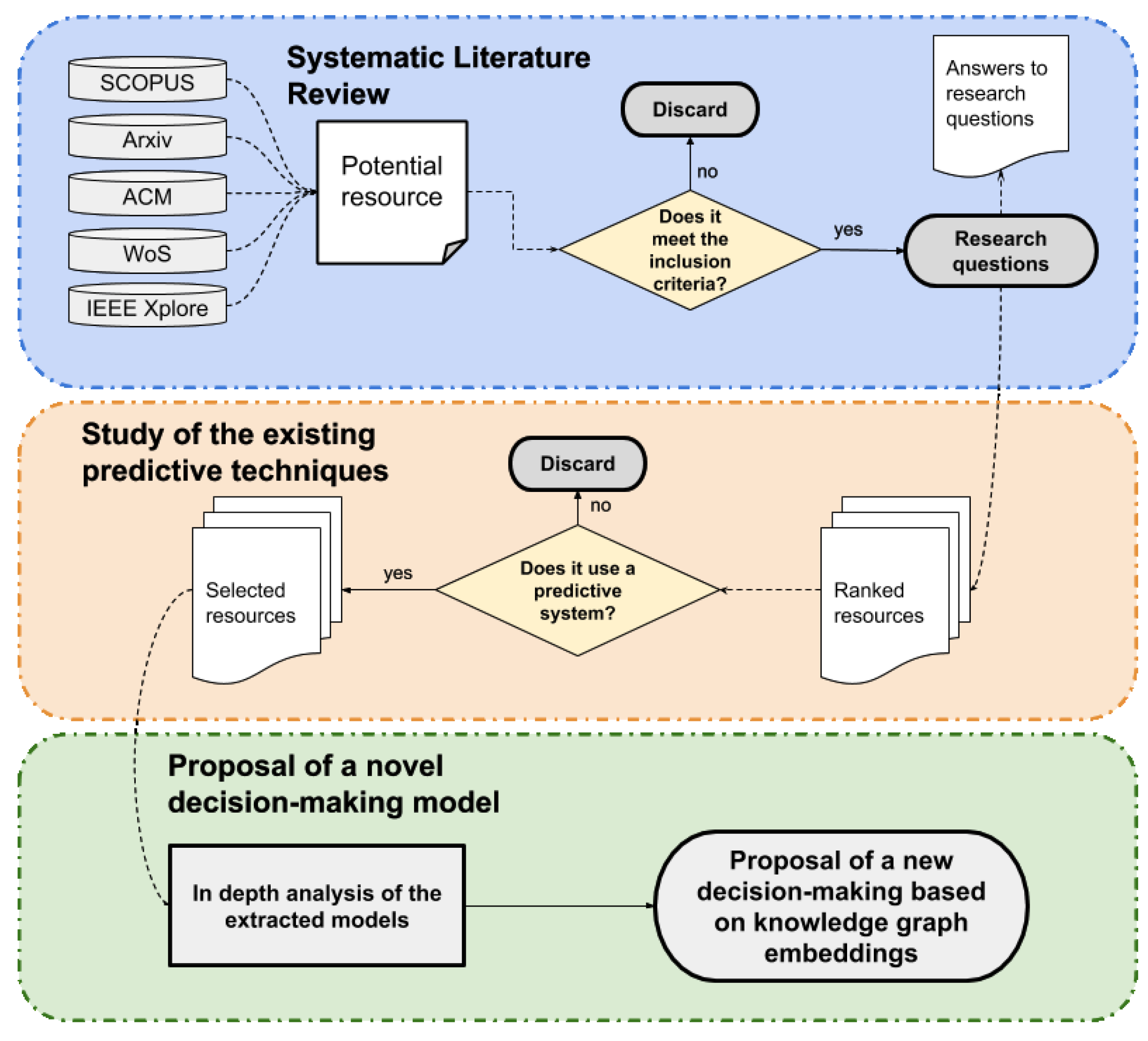
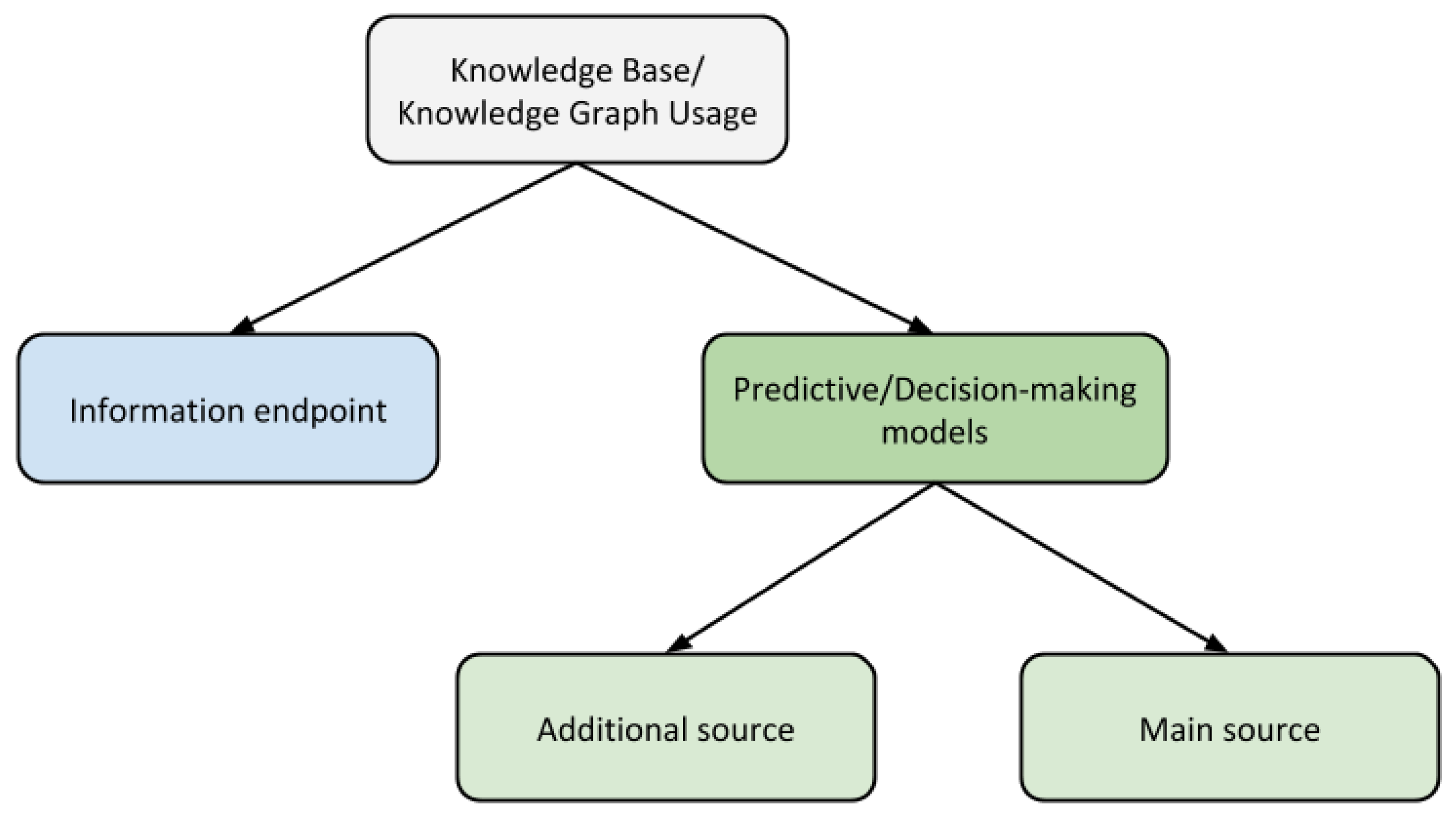
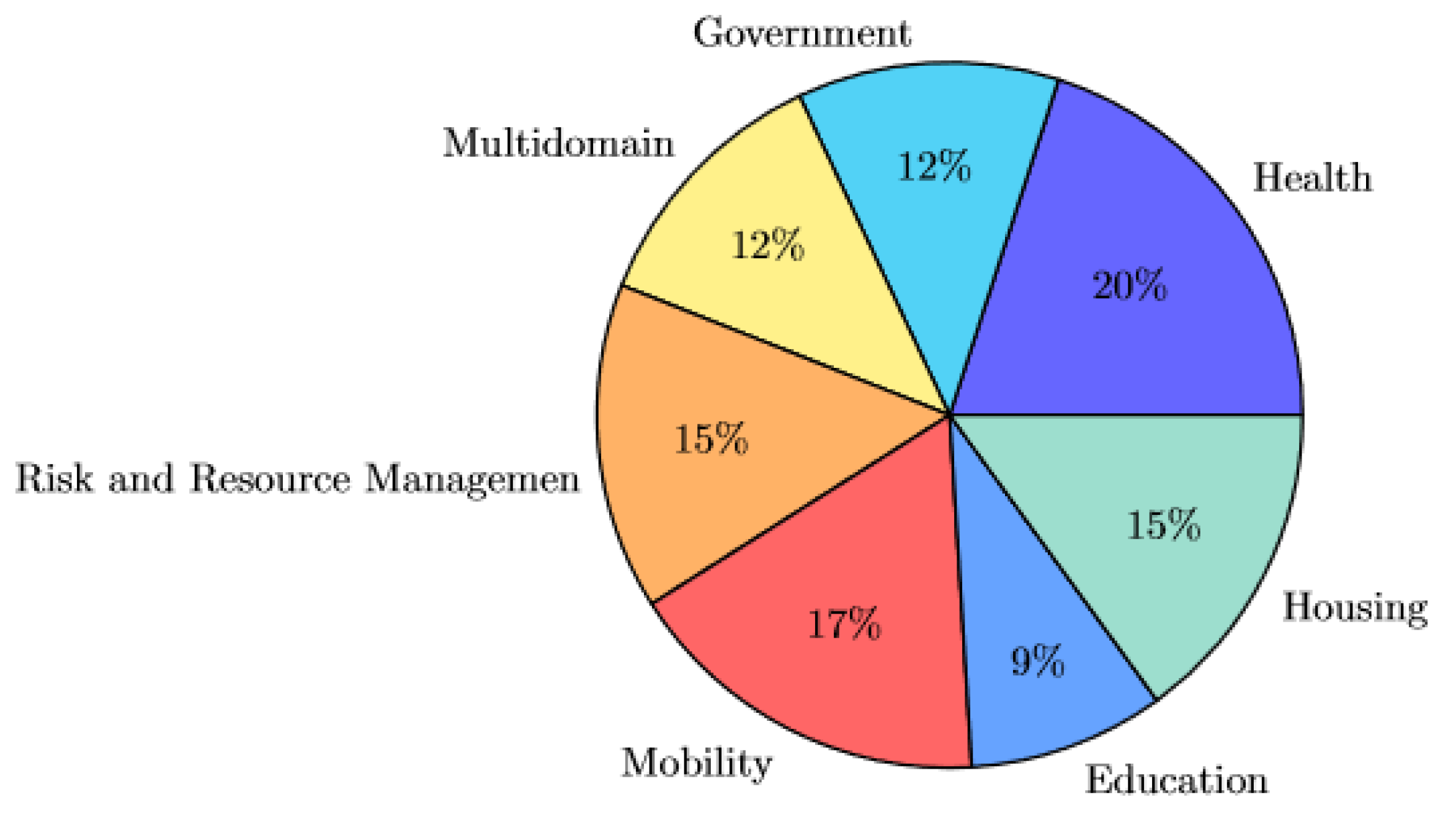
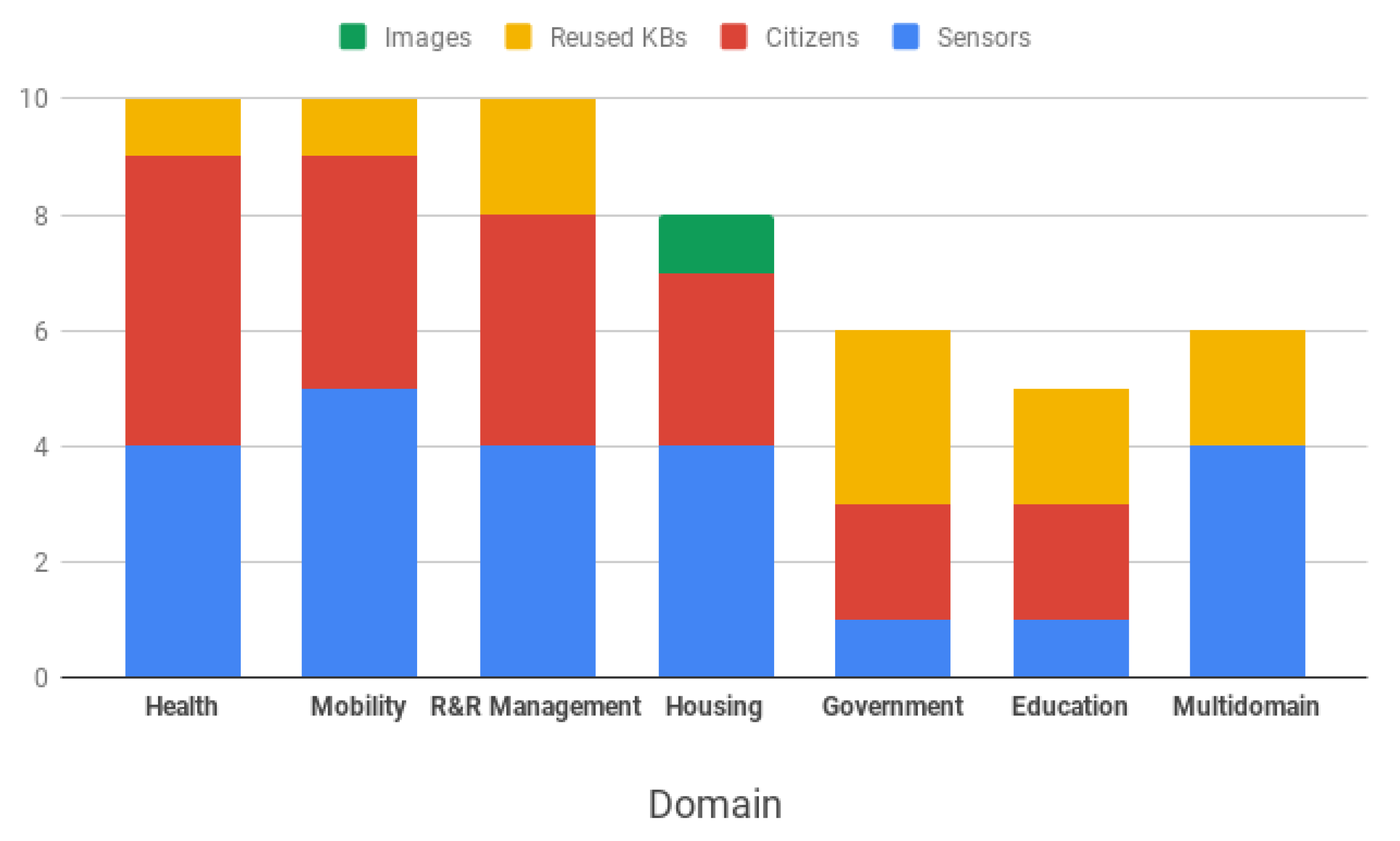
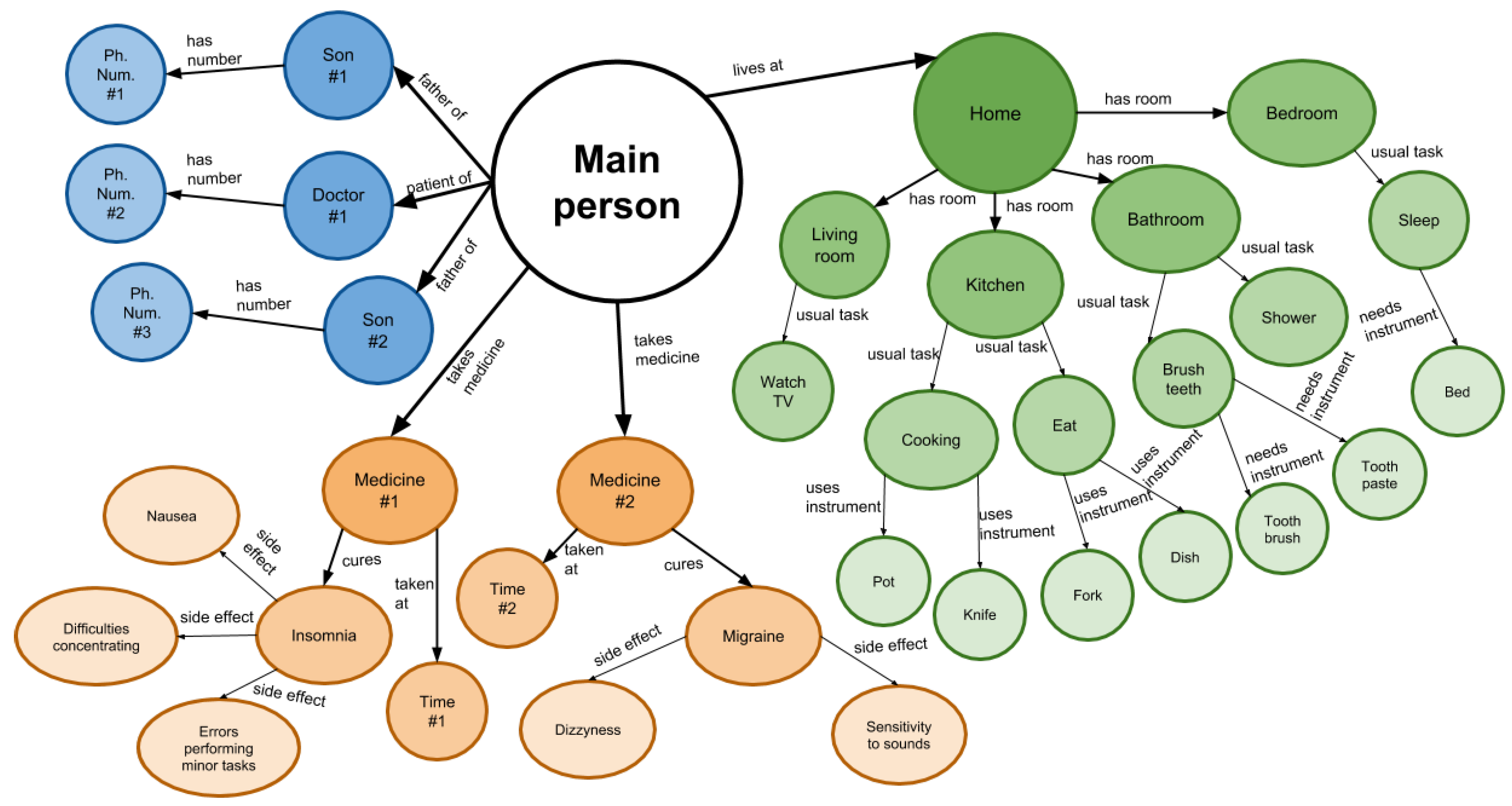
| Source | Total Results | Selected Resources |
|---|---|---|
| SCOPUS | 149 | 21 |
| Arxiv | 49 | 4 |
| ACM | 12 | 0 |
| Web of Science | 36 | 1 |
| IEEE Xplore | 87 | 8 |
| TOTAL | 333 | 34 |
| Inclusion | Exclusion |
|---|---|
| Papers written in English | Papers not written in English |
| Papers that provide a clear insight into the usage of the knowledge base | Works published before 2012 |
| Works that present a methodology for knowledge base generation in the given context | Papers that include one of the search terms amongst its keywords but do not make any further reference to them |
| Resource | C1 | C2 | C3 | C4 | C5 | Relevance Factor |
|---|---|---|---|---|---|---|
| Sii-Mobility [16,17,18] | X | X | X | X | X | 5 |
| 3cixty [19] | X | X | X | 3 | ||
| Persaud et al. [20] | X | X | X | X | 4 | |
| Olszewski et al. [21] | X | X | X | 3 | ||
| Kim and Chung [22] | X | X | X | 3 | ||
| Xiaobo et al. [23] | X | X | X | 3 | ||
| Giannakopoulou et al. [24] | X | X | X | 3 | ||
| Orłowski et al. [25] | X | X | X | 3 | ||
| Olszewski and Turek [26] | X | X | X | 3 | ||
| Chung et al. [27] | X | X | X | / | 3, 5 | |
| Barnwal et al. [28] | X | X | X | 3 | ||
| Bogale et al. [29] | X | X | X | X | 4 | |
| Zavala et al. [30] | X | X | X | 3 | ||
| Zhou et al. [31] | X | X | X | 3 | ||
| Xu and Li [32] | X | X | X | 3 | ||
| Duyen and Nhon [33] | X | X | X | 3 | ||
| Roffia et al. [34] | X | X | X | 3 | ||
| Peral et al. [35] | X | X | X | X | 4 | |
| Qiu et al. [36] | X | X | X | 3 | ||
| Shan and Cao [37] | X | X | X | 3 | ||
| Santos et al. [38] | X | X | X | 3 | ||
| Schoonenberg and Farid [38] | X | X | X | 3 | ||
| Aguilar et al. [39] | X | X | X | / | 3, 5 | |
| Ali and Lee [40] | X | X | X | 3 | ||
| Hao et al. [41] | X | X | X | X | / | 4, 5 |
| Kim and Chung [42] | X | X | X | X | X | 5 |
| Chung et al. [43] | X | X | X | X | X | 5 |
| Machado et al. [44] | X | X | X | X | X | 5 |
| Dimitrov et al. [45] | X | X | X | X | X | 5 |
| Rhee et al. [46] | X | X | X | 3 | ||
| Martín-Ruiz et al. [47] | X | X | X | X | 4 | |
| Sermet and Demir [48] | X | X | X | 3 | ||
| Fast et al. [49] | X | X | X | X | 4 | |
| Riboni et al. [50] | X | X | X | X | X | 5 |
| Resource | Domain | Predictive Technique | Scalability | Interpretability | Abstraction Capability | Low Resource Consumption | Relevance of KB | Overall Score |
|---|---|---|---|---|---|---|---|---|
| Ali and Lee [40] | Health | Rules Manually Created by Experts | X | X | X | 3 | ||
| Barnwal et al. [28] | Risk/Resource Management | Probabilistic distributions | X | X | X | 3 | ||
| Bogale et al. [29] | Multidomain | Multivariate Linear Regression | / | / | / | X | X | 3.5 |
| Chung et al. [43] | Health | Deep Neural Network | X | X | X | 3 | ||
| Dimitrov et al. [45] | Housing | Bayesian Network [59] | X | X | X | 3 | ||
| Duyen and Nhon [33] | Education | If-then manually created rules | X | X | X | 3 | ||
| Fast et al. [49] | Housing | Word2Vec vector generation + cosine distance comparison | X | X | X | / | X | 4.5 |
| Hao et al. [41] | Housing | Half-Duplex Search algorithm | X | X | X | 3 | ||
| Kim and Chung [42] | Health | Neural Network | X | X | / | 2.5 | ||
| Kim and Chung [22] | Health | Pearson’s correlation coefficient + Collaborative Filtering [60,61,62] | X | X | X | 3 | ||
| Machado et al. [44] | Housing | Multi-entity Bayesian Networks [63] | X | / | X | 2.5 | ||
| Martín-Ruiz et al. [47] | Health | Rules manually created by experts | X | X | X | 3 | ||
| Olszewski and Turek [26] | Mobility | CART Trees [64] | / | X | X | X | X | 4.5 |
| Olszewski et al. [21] | Government | Fuzzy logical rules [65] | X | / | X | X | 3.5 | |
| Orlowski et al. [25] | Mobility | Fuzzy logical rules | X | / | X | X | 3.5 | |
| Peral et al. [35] | Health | C4.5 Tree [66] | X | X | / | 2.5 | ||
| Persaud et al. [20] | Mobility | Deep Neural Network | X | X | / | 2.5 | ||
| Riboni et al. [50] | Health | Random Forest [67] | X | / | X | / | X | 4 |
| Sii-Mobility [16,17,18] | Mobility | Bayesian Regression ANNs [68,69,70] | X | / | X | / | X | 4 |
| Xu and Li [32] | Risk/Resource Management | Fuzzy logical rules | X | / | X | X | 3.5 | |
| Zavala et al. [30] | Mobility | RIPPER rules [71] | X | X | X | 3 |
© 2019 by the authors. Licensee MDPI, Basel, Switzerland. This article is an open access article distributed under the terms and conditions of the Creative Commons Attribution (CC BY) license (http://creativecommons.org/licenses/by/4.0/).
Share and Cite
Amador-Domínguez, E.; Serrano, E.; Manrique, D.; De Paz, J.F. Prediction and Decision-Making in Intelligent Environments Supported by Knowledge Graphs, A Systematic Review. Sensors 2019, 19, 1774. https://doi.org/10.3390/s19081774
Amador-Domínguez E, Serrano E, Manrique D, De Paz JF. Prediction and Decision-Making in Intelligent Environments Supported by Knowledge Graphs, A Systematic Review. Sensors. 2019; 19(8):1774. https://doi.org/10.3390/s19081774
Chicago/Turabian StyleAmador-Domínguez, Elvira, Emilio Serrano, Daniel Manrique, and Juan F. De Paz. 2019. "Prediction and Decision-Making in Intelligent Environments Supported by Knowledge Graphs, A Systematic Review" Sensors 19, no. 8: 1774. https://doi.org/10.3390/s19081774
APA StyleAmador-Domínguez, E., Serrano, E., Manrique, D., & De Paz, J. F. (2019). Prediction and Decision-Making in Intelligent Environments Supported by Knowledge Graphs, A Systematic Review. Sensors, 19(8), 1774. https://doi.org/10.3390/s19081774







